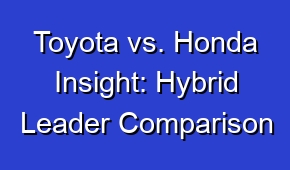Hybrid Cars: The Best of Both Worlds

Hybrid cars offer the best of both worlds, combining the fuel efficiency of electric power with the range and convenience of traditional gasoline engines. Discover how these innovative vehicles are revolutionizing the automotive industry.
Hybrid cars offer the best of both worlds when it comes to fuel efficiency and environmental friendliness. These vehicles combine the power of a traditional gasoline engine with the clean energy of an electric motor, resulting in reduced emissions and increased mileage. With rising concerns about climate change and the need for sustainable transportation options, hybrid cars have become increasingly popular among eco-conscious consumers. The hybrid car market has seen significant growth in recent years, with automakers continuously improving their technology to deliver better performance and longer battery life. Not only do hybrids help reduce our carbon footprint, but they also provide drivers with the convenience of longer driving ranges and fewer trips to the gas station. In addition, many governments offer incentives and tax credits for purchasing hybrid vehicles, making them an attractive choice for budget-conscious individuals. By choosing a hybrid car, you can enjoy the benefits of both gasoline and electric power, contributing to a greener future.
| Hybrid cars combine the benefits of both gasoline and electric power. |
| Hybrid cars offer improved fuel efficiency compared to traditional gasoline-powered vehicles. |
| With dual power sources, hybrid cars have reduced emissions and are more environmentally friendly. |
| Hybrid cars use regenerative braking to charge their batteries and increase energy efficiency. |
| The electric motor in hybrid cars provides instant torque for quick acceleration. |
- Hybrid cars help reduce dependence on fossil fuels and promote sustainability.
- The combination of a gasoline engine and an electric motor allows hybrid cars to achieve longer driving ranges.
- Hybrid cars can automatically switch between power sources to optimize fuel economy.
- The battery pack in hybrid cars is designed to last for the lifetime of the vehicle.
- Regenerative braking in hybrid cars helps to extend the lifespan of brake pads.
What are the advantages of hybrid cars?
Hybrid cars offer several advantages that make them appealing to many drivers. One of the main advantages is their improved fuel efficiency. By combining an internal combustion engine with an electric motor, hybrid cars can achieve better mileage and reduce fuel consumption compared to traditional gasoline-powered vehicles. This not only saves money on fuel costs but also helps to reduce carbon emissions and protect the environment.
| Reduced Fuel Consumption | Lower Emissions | Increased Energy Efficiency |
| Hybrid cars combine a gasoline engine with an electric motor, resulting in significantly lower fuel consumption compared to traditional cars. | Hybrid cars produce fewer emissions, especially greenhouse gases, contributing to a cleaner and healthier environment. | Hybrid cars are designed to optimize energy usage, capturing and utilizing energy that is typically wasted in traditional vehicles. |
| Regenerative Braking | Quiet Operation | Government Incentives |
| Hybrid cars utilize regenerative braking, which converts kinetic energy into electrical energy, further enhancing fuel efficiency. | Hybrid cars operate quietly, reducing noise pollution and providing a more peaceful driving experience. | Many governments provide incentives such as tax credits and rebates to encourage the purchase of hybrid cars, making them more affordable. |
Another advantage of hybrid cars is their ability to switch between gasoline and electric power. This allows for greater flexibility in different driving conditions. For example, in stop-and-go traffic or during low-speed city driving, the electric motor can power the vehicle, reducing fuel consumption and emissions. On the other hand, when more power is needed for acceleration or highway driving, the gasoline engine can kick in to provide additional power.
How do hybrid cars work?
Hybrid cars work by combining the use of an internal combustion engine and an electric motor. The internal combustion engine runs on gasoline, while the electric motor is powered by a battery pack. These two power sources work together to optimize fuel efficiency and reduce emissions.
- Hybrid cars combine an internal combustion engine with an electric motor to provide power.
- These cars use regenerative braking, which means that when the brakes are applied, the electric motor acts as a generator and converts the energy from the moving car into electricity, which is then stored in the battery.
- Hybrid cars also have a system called start-stop, which automatically shuts off the engine when the car is stationary, such as at a red light, to save fuel. When the driver releases the brake pedal, the engine starts again.
During normal driving conditions, the hybrid car will use a combination of both the gasoline engine and electric motor. The car’s computer system determines how much power is needed and switches between the two sources accordingly. In some cases, such as during low-speed or stop-and-go driving, the car may rely solely on electric power, using the gasoline engine only when necessary.
Are hybrid cars more expensive to maintain?
Maintaining a hybrid car can be slightly different from maintaining a traditional gasoline-powered vehicle, but it does not necessarily mean it is more expensive. While some components unique to hybrid cars, such as the battery pack, may require eventual replacement, advancements in technology have made these components more durable and long-lasting.
- Hybrid cars typically have more complex and advanced technology, which can lead to higher repair costs.
- The batteries in hybrid cars may need to be replaced after a certain number of years, which can be expensive.
- Hybrid cars often require specialized mechanics or dealerships for maintenance, which can be more costly than regular car maintenance.
- The parts for hybrid cars can be more expensive than those for traditional cars.
- Some hybrid cars have unique features, such as regenerative braking, that may require additional maintenance and repairs.
Additionally, hybrid cars often have regenerative braking systems, which can help to extend the life of brake pads and reduce maintenance costs. The overall maintenance costs of a hybrid car can vary depending on the specific model and its components, but in general, they are comparable to those of traditional vehicles.
What is the difference between a hybrid car and an electric car?
The main difference between a hybrid car and an electric car is how they are powered. Hybrid cars use both an internal combustion engine and an electric motor, while electric cars rely solely on electricity.
| Hybrid Car | Electric Car |
| Combines a gasoline engine with an electric motor. | Powered solely by an electric motor. |
| Uses both gasoline and electricity to power the vehicle. | Relies on a rechargeable battery for power. |
| Can switch between the gasoline engine and electric motor or use them together. | Does not have a gasoline engine and operates only on electric power. |
Hybrid cars have the advantage of being able to switch between gasoline and electric power, offering greater flexibility in terms of range and refueling options. They typically have smaller battery packs compared to electric cars, which means they can rely on gasoline for longer distances. Electric cars, on the other hand, need to be charged regularly and have a limited range based on their battery capacity.
Do hybrid cars require special charging stations?
Hybrid cars do not require special charging stations like fully electric vehicles do. Since hybrid cars have both an internal combustion engine and an electric motor, they do not solely rely on charging from an external power source.
Hybrid cars do not require special charging stations as they can be charged using a regular power outlet.
hybrid cars, special charging stations, regular power outlet
Hybrid cars use regenerative braking systems to recharge their batteries while driving, and they also utilize the gasoline engine to generate electricity. This means that hybrid car owners can simply refuel at regular gas stations without the need for specialized charging infrastructure.
Are hybrid cars better for the environment?
Hybrid cars are generally considered to be better for the environment compared to traditional gasoline-powered vehicles. Their improved fuel efficiency helps to reduce carbon emissions and decrease the overall environmental impact.
Hybrid cars are considered better for the environment due to their lower emissions and higher fuel efficiency.
By relying on both gasoline and electric power, hybrid cars can achieve better mileage and consume less fuel. This not only reduces greenhouse gas emissions but also decreases dependence on fossil fuels. Additionally, hybrid cars often incorporate other eco-friendly features such as regenerative braking systems and energy-efficient components.
What are the different types of hybrid cars?
There are several different types of hybrid cars available on the market. The most common types include:
Parallel Hybrid Cars
A parallel hybrid car is the most common type of hybrid vehicle. It has both an internal combustion engine (ICE) and an electric motor. The ICE and the electric motor can work together or independently to power the car. In this type of hybrid, the electric motor assists the ICE, especially during acceleration and low-speed driving. The ICE is responsible for providing power during high-speed driving and when the battery is depleted. Examples of parallel hybrid cars include the Toyota Prius and the Honda Insight.
Series Hybrid Cars
In a series hybrid car, the electric motor is the primary source of power. The internal combustion engine in a series hybrid is used solely to charge the battery that powers the electric motor. The ICE does not directly drive the wheels. This type of hybrid is more efficient in city driving conditions, where frequent stops and starts allow the electric motor to work at its best. The BMW i3 with Range Extender is an example of a series hybrid car.
Plug-In Hybrid Cars
Plug-in hybrid cars, also known as PHEVs, are similar to parallel hybrids but with a larger battery. These vehicles can be charged by plugging them into an external power source, such as an electrical outlet. The larger battery capacity allows plug-in hybrids to travel longer distances on electric power alone. Once the battery is depleted, the vehicle operates like a regular parallel hybrid. Some popular plug-in hybrid models include the Chevrolet Volt and the Mitsubishi Outlander PHEV.
– Full hybrids: These hybrids can run on either the gasoline engine or the electric motor separately or a combination of both. They offer the most flexibility in terms of power sources and fuel efficiency.
– Mild hybrids: These hybrids primarily rely on the gasoline engine, with the electric motor providing assistance during acceleration or other high-demand situations.
– Plug-in hybrids: These hybrids have larger battery packs that can be charged from an external power source. They offer extended electric-only driving range and can be recharged by plugging them into a charging station or outlet.
– Series hybrids: These hybrids use the gasoline engine solely to generate electricity, which powers the electric motor. The gasoline engine does not directly drive the wheels.
– Parallel hybrids: These hybrids use both the gasoline engine and electric motor to directly power the wheels. They can operate in different modes depending on the driving conditions.





















